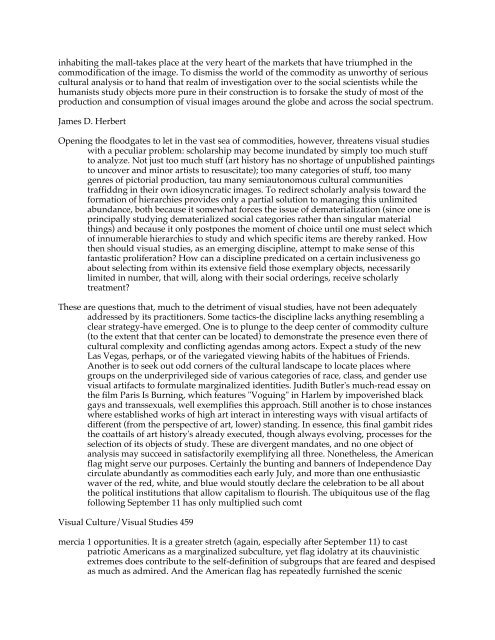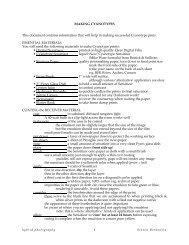Chapter Thirty Visual Culture/Visual Studies
Chapter Thirty Visual Culture/Visual Studies
Chapter Thirty Visual Culture/Visual Studies
Create successful ePaper yourself
Turn your PDF publications into a flip-book with our unique Google optimized e-Paper software.
inhabiting the mall-takes place at the very heart of the markets that have triumphed in the<br />
commodification of the image. To dismiss the world of the commodity as unworthy of serious<br />
cultural analysis or to hand that realm of investigation over to the social scientists while the<br />
humanists study objects more pure in their construction is to forsake the study of most of the<br />
production and consumption of visual images around the globe and across the social spectrum.<br />
James D. Herbert<br />
Opening the floodgates to let in the vast sea of commodities, however, threatens visual studies<br />
with a peculiar problem: scholarship may become inundated by simply too much stuff<br />
to analyze. Not just too much stuff (art history has no shortage of unpublished paintings<br />
to uncover and minor artists to resuscitate); too many categories of stuff, too many<br />
genres of pictorial production, tau many semiautonomous cultural communities<br />
traffiddng in their own idiosyncratic images. To redirect scholarly analysis toward the<br />
formation of hierarchies provides only a partial solution to managing this unlimited<br />
abundance, both because it somewhat forces the issue of dematerialization (since one is<br />
principally studying dematerialized social categories rather than singular material<br />
things) and because it only postpones the moment of choice until one must select which<br />
of innumerable hierarchies to study and which specific items are thereby ranked. How<br />
then should visual studies, as an emerging discipline, attempt to make sense of this<br />
fantastic proliferation? How can a discipline predicated on a certain inclusiveness go<br />
about selecting from within its extensive field those exemplary objects, necessarily<br />
limited in number, that will, along with their social orderings, receive scholarly<br />
treatment?<br />
These are questions that, much to the detriment of visual studies, have not been adequately<br />
addressed by its practitioners. Some tactics-the discipline lacks anything resembling a<br />
clear strategy-have emerged. One is to plunge to the deep center of commodity culture<br />
(to the extent that that center can be located) to demonstrate the presence even there of<br />
cultural complexity and conflicting agendas among actors. Expect a study of the new<br />
Las Vegas, perhaps, or of the variegated viewing habits of the habitues of Friends.<br />
Another is to seek out odd corners of the cultural landscape to locate places where<br />
groups on the underprivileged side of various categories of race, class, and gender use<br />
visual artifacts to formulate marginalized identities. Judith Butler's much-read essay on<br />
the film Paris Is Burning, which features "Voguing" in Harlem by impoverished black<br />
gays and transsexuals, well exemplifies this approach. Still another is to chose instances<br />
where established works of high art interact in interesting ways with visual artifacts of<br />
different (from the perspective of art, lower) standing. In essence, this final gambit rides<br />
the coattails of art history's already executed, though always evolving, processes for the<br />
selection of its objects of study. These are divergent mandates, and no one object of<br />
analysis may succeed in satisfactorily exemplifying all three. Nonetheless, the American<br />
flag might serve our purposes. Certainly the bunting and banners of Independence Day<br />
circulate abundantly as commodities each early July, and more than one enthusiastic<br />
waver of the red, white, and blue would stoutly declare the celebration to be all about<br />
the political institutions that allow capitalism to flourish. The ubiquitous use of the flag<br />
following September 11 has only multiplied such comt<br />
<strong>Visual</strong> <strong>Culture</strong>/<strong>Visual</strong> <strong>Studies</strong> 459<br />
mercia 1 opportunities. It is a greater stretch (again, especially after September 11) to cast<br />
patriotic Americans as a marginalized subculture, yet flag idolatry at its chauvinistic<br />
extremes does contribute to the self-definition of subgroups that are feared and despised<br />
as much as admired. And the American flag has repeatedly furnished the scenic







